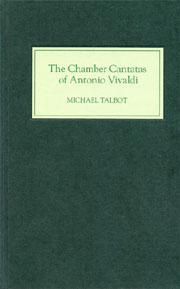Book contents
- Frontmatter
- Contents
- List of music examples
- List of tables
- Preface
- Conventions and abbreviations
- 1 The Rediscovery of Vivaldi's Cantatas
- 2 The Cantata Genre
- 3 Vivaldi and the Voice
- 4 The Mantuan Cantatas
- 5 Cantatas of the Middle Years
- 6 The Dresden Cantatas
- 7 Vivaldi's Cantatas in Perspective
- Glossary
- List of Vivaldi's cantatas published in the New Critical Edition
- Spurious works
- Bibliography
- Index to musical works
- General index
5 - Cantatas of the Middle Years
Published online by Cambridge University Press: 12 September 2012
- Frontmatter
- Contents
- List of music examples
- List of tables
- Preface
- Conventions and abbreviations
- 1 The Rediscovery of Vivaldi's Cantatas
- 2 The Cantata Genre
- 3 Vivaldi and the Voice
- 4 The Mantuan Cantatas
- 5 Cantatas of the Middle Years
- 6 The Dresden Cantatas
- 7 Vivaldi's Cantatas in Perspective
- Glossary
- List of Vivaldi's cantatas published in the New Critical Edition
- Spurious works
- Bibliography
- Index to musical works
- General index
Summary
Vivaldi's Blütezeit
The 1720s were Vivaldi's glory years. On his return from Mantua, he slipped back effortlessly into his former pattern of activity. In October 1720 his new opera La verità in cimento signalled, just in time for Marcello's satire, his return to the world of Venetian opera. Very soon, he became an operatic composer in demand outside Venice. In 1721 he received a scrittura (commission) for Milan. Commissions for Rome (1723, 1724), Mantua (1725), Florence (1727), and Reggio Emilia (1727) followed. Many of these external commissions required him to take personal charge of the performance in situ, obliging him, despite his precarious health (his strettezza di petto has been identified with near certainty as bronchial asthma), to venture abroad. Within Venice, his career as a composer of opera was reinforced in many seasons by his direction of the music at the S. Angelo theatre, which allowed him, so to speak, to offer himself commissions, while choosing as partner composers younger men who as yet posed no threat to his dominance.
Like several other Venetian opera composers (Lotti and Albinoni spring to mind), Vivaldi established a close partnership with a leading female singer. Since he was a priest, there was no question of pursuing this relationship as far as marriage – tongues wagged furiously enough at the mere suggestion of a close professional association. The singer was Anna Tessieri (better known as Anna Girò), who, together with her half-sister and chaperone Paola, formed part of Vivaldi's entourage from the mid-1720s onwards.
- Type
- Chapter
- Information
- The Chamber Cantatas of Antonio Vivaldi , pp. 120 - 163Publisher: Boydell & BrewerPrint publication year: 2006



